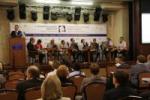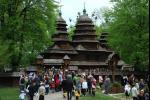The Liberating War in the mid 17th Century
The Liberating War in the mid 17th century had become an event of great significance that fundamentally changed the further development of Ukrainian history. Its most important result was the formation of the independent Ukrainian state.
The war began in February 1648 from the conquering of the Sich by rebels and election of Bohdan Khmelnytskyi (1595-1657) who was the Chyhyryn sotnyk, as Hetman of the Zaporizhian Army. News about the events in Zaporizhia quickly spread across Ukrainian land and drew the broadest circle of the population into the rebellion. The success of the rebels was insured by the activity of the newly elected Hetman oriented to the rebellion expansion of the districts. He was soon winning over to his side the register of Cossacks along with a formation of the national army, and he was avoiding the premature military actions with the Polish Army.
The Liberating War in the mid 17th century had become an event of great significance that fundamentally changed the further development of Ukrainian history. Its most important result was the formation of the independent Ukrainian state.
Two processes had been distinctly crystallized at the beginning of the Liberating War: state formation and a complete change in the principal model of socio-economic relations. The triumphal attack of the Cossack Army in the spring and summer of 1648 was responsible for the liberation from the reign of Polish squires of the vast territories of Ukraine (battles under Korsun and Zhovti Vody). There was also the defeat of Poles under Pyliavtsi and a raid of the Cossack Army to the vicinities of Lviv and Zamostia which had determined the essential change in Hetman's political plans.
The idea of Cossack autonomy within the limits of the Kingdom of Poland was inferior to that of the necessity of complete defeat of Rich Pospolyta and creation of their own state. The foundations of this state had been laid by the end of 1648 in most parts of Ukrainian territory. Inbetween June-November 1648, the process of forming national state institutions was mainly completed in the central, southern and eastern regions, while in the western regions they were in the intensive process of a formation of the old administrative territory. This was replaced with a new regiment-sotnia the Cossacks' court and judicial procedure that introduced the National Army that formed serious changes that could be observed in the social structure of the population. The Cossacks' played a leading part in ruining the Polish state and in the formation of Ukrainian state institutions.
The close links between national liberation and social struggle at the very beginning of the war were a characteristic feature of the time. It was a social struggle that played an exceptionally important part in the formation of the new socio-economic system of the Ukrainian state. Hundreds of detachments of the peasants and townsmen ruined the estates of squires, destroyed shliakhta, leaders, village magistrates and Catholic churchmen. The Cossack ideal became a generator of the activities for masses of peasants. Their conscience imagined the Cossack to be a man free from any obligations (except for military) before a squire and a state. This is the reason that the struggle for obtaining the Cossack immunity (personal freedom, the right to possess land, to be under their own jurisdiction) became the all-Ukrainian phenomenon during this time . The social struggle resulted in the peasants' war which for the first time in the history of Ukraine embraced the greatest part of its territory and proved to be an especially important factor in the development of national revolution. Peasants refused to perform numerous duties in favor of their landlords (statute labor in particular). The Liberating War opened a possibility of transfer of peasants and townsmen to the status of Cossacks who had a lot of rights and privileges at that time. At the same time, the Cossack officers also consolidated their positions during the years of war. They also took the road of material enrichment and wanted to secure the ownership of land and acquire production enterprises.
The lessons of the first war allowed Bohdan Khmelnytskyi to make certain corrections in his political program early in 1649. Henceforth, his first rate task was to unify all ethno-Ukrainian lands in the limits of the national state. A new program also provided for the recognition of social gains of the people masses, and consolidation of the Hetman's power.
The period from 1649 to 1652 was characterized by the active efforts of the young state to firmly establish itself in the world arena. The Hetman's government made a military-political union with the Crimean Khanate that carried on active negotiations with Moscow and Warsaw, and established diplomatic relations with Porta, Moldova, and Transylvania.
Extremely unfavorable geopolitical situations interfered with Khmelnytskyi's plans. The Hetman had to make the Zboriv agreement in August 1649 in order to avoid the Union of Crimean Khan Islam Hirey with the King of Poland, Yan Kazymir. The agreement though recognizing the existence of the Cossack states, limited its territory by Bratslav, Kyiv and the Chernihiv provinces. It also abolished a number of social gains of the Ukrainian people. And so the Cossacks and peasants took up arms once again. Mass actions in a number of regions took place for much of 1650. The threat of civil war was avoided because of Khmelnytskyi's social policy.
The ruling circles of Rich Pospolyta tended to decide the Ukrainian problem by methods of war. In February 1651, the Polish Army passed to the offensive. A new military campaign was started which nearly turned into a catastrophe because of the insidious Crimean Khan under the town of Berestechko. This agreement was signed in September 1651 in Bila Tserkva. The terms of this agreement greatly limited autonomy, which evoked mass discontent among the Ukrainian people. Patriotic enthusiasm embraced Ukraine. Khmelnytskyi mobilized the army and won a great victory in the battle near the settlement of Batih against the Polish Army on May 23, 1652. Nearly the entire Ukrainian territory was liberated from Polish oppression. However, the development of this victory was not successful. The anti-Ukraine coalition, which included Rich Pospolyta, Moldova, Valakhia and Transylvania was created in the summer of 1653. The Crimea-Porta relation grew worse. Under these conditions, the relations with Moscow assumed a peculiar place in the Hetman's political plans. In the opinion of the Ukrainian ruler, the orientation to the Moscow state could provide for them despite the changes that had occurred at that time in Ukraine. The changes were the liberation from Polish power, the functioning of Ukraine as an independent state, and the reunification in the future of all Ukrainian lands under the Hetman's hist mace. After long-term negotiations, Ukraine consented to embrace the protectorate of Moscow. On October 1, 1653, a corresponding resolution was passed by the Zemstvo Council, which was the highest representative body of the Moscow State. On January 8, 1654, the decision on the Zaporizhian Army subjection to the Moscow Tsar was made by the participants of the Pereiaslav Rada.
This agreement provided for the preservation of the political system that existed in Ukraine, the army, the in-force model of socio-economic relations, and rights for making an independent home policy. Partial control was established only over its foreign-political activities and taxation policy. The agreement of 1654 ratified the creation of a confederation and a military union. However, being a part of monarchic Moscow, the Ukrainian state was deprived of prospects of development.
After 1654, a new stage in the course of the Liberating War began. The aim of the Ukrainian state to destroy Rich Pospolyta and to reunite all ethno-Ukrainian lands within the Cossack territory was invariable. As a result of miscalculations by the Moscow government in evaluating the military-political situation, the military campaign from the autumn of 1654 to winter of 1655 resulted in an awful ravage of the Bratslav province. Hetman Khmelnytskyi began searching for allies among other countries. He succeeded in improving relations with the Crimea and Turkey, modified relations with Transylvania, and created an important alliance with Sweden.
At about the same time, Moscow was intimidated by the success of the Swedish Army, and signed the Vilno truce agreement with Rich Pospolyta in August 1656. They then began military actions against Karl X. When he had come to know about Moscow's change in the foreign-political course, the Hetman Khmelnytskyi understood its balefullness for realization of the program of reuniting Ukrainian lands and began looking for the ways to create an anti-Poland coalition with Sweden and Transylvania. He set his special hopes on the success of the Ukrainian-Transylvanian raid on Poland which had a tragic end for the troops of Gyorgy II Rakoczi. The failed raid meant a crash in the plans of Ukraine to be sovereign and to win the victory in the struggle with Rich Pospolyta in a coalition with Sweden and Transylvania. The internal situation in Ukraine also became worse. The Hetman's influence on the settlement of state affairs weakened due to poor health. The growth of social strength became noticeable, and the will of Cossack officers increased and some groups were fighting for power. During this time, the Tsar's government activated the measures on the limitation of autonomous rights of Ukraine. During the most critical period of this time, Hetman Bohdan Khmelnytskyi died on July 27, 1657.








